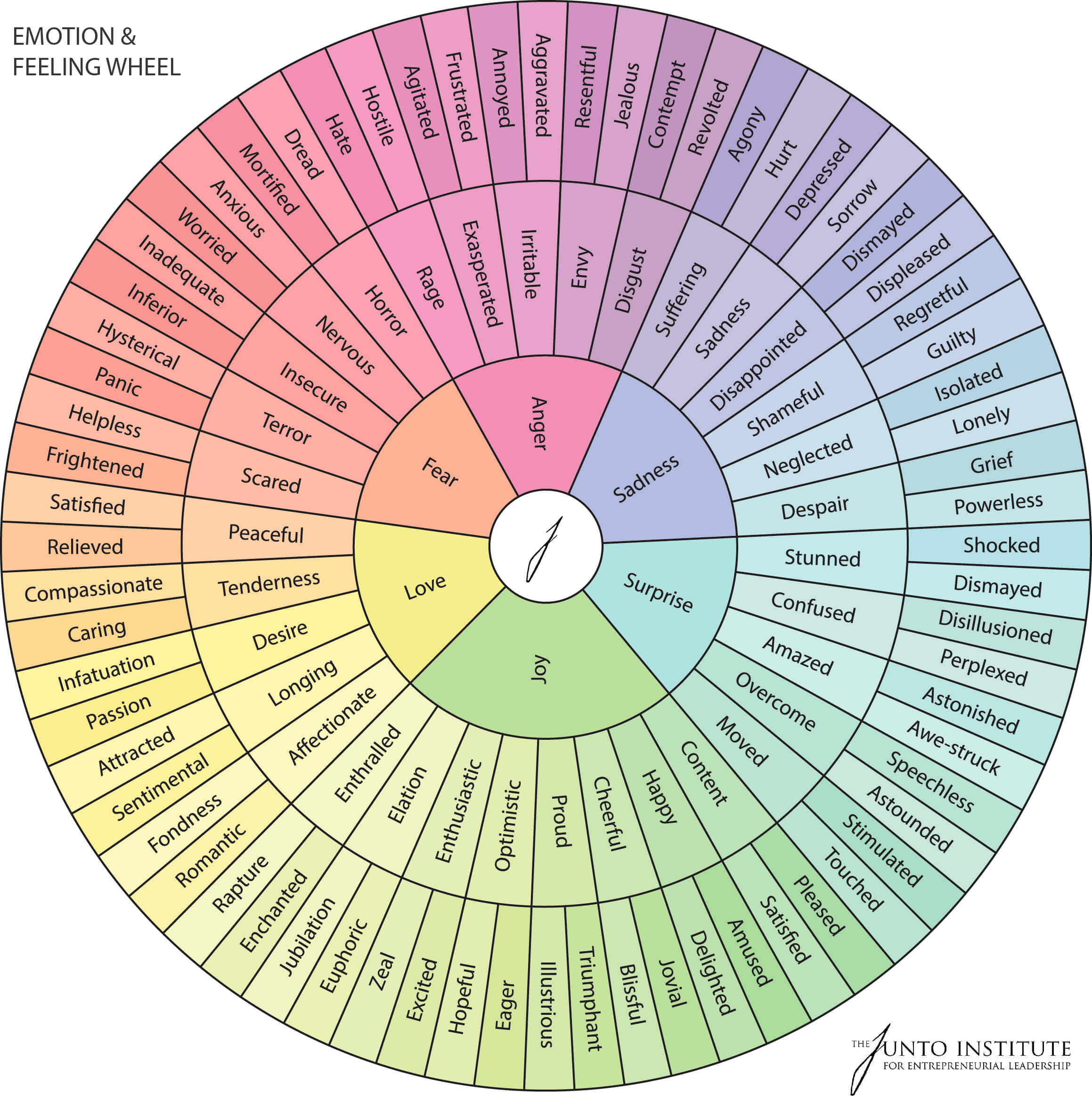
The human brain is one of the most complex things in the universe.
It has been estimated that there are 10-20 billion neurons in our brains, with over 100 trillion connections between them. It can be challenging to keep track of what is happening when there are so many emotions and feelings swirling around.
It can be challenging to follow along and understand what each emotion is trying to express in order to develop Emotional Intelligence (EI or EQ). This can make you feel frustrated and upset. This has an impact on our experiences and how we behave.
So what’s the solution? Well, that’s what emotional wheels are for — to help us better understand our emotions, ourselves, others, and the world around us.
The emotion wheel is a simple but powerful tool to help you analyze the different moods and emotions that you feel. The more we get the ball of emotions rolling, the easier it will be for us to live a happier and more peaceful life.
Why We Need the Emotional Wheel?
The emotional wheel is a visual and linguistic model that helps people acknowledge, experience, and express their emotions, understand them better, and channel them in the right direction.
Emotional wheels are an introspective technique that helps you connect to your emotions and make sense of them, which will help you make better decisions. It is a powerful way to boost your self-esteem, motivation, and confidence and empower us with positive emotions.
The basic concept of emotional wheels
Emotional wheels work on the principle of overcoming emotional dependency. Emotional dependence is a tendency to feel trapped by emotions, being unable to act on rational, logical decisions even when these decisions lead to more ‘good’ results. In addition, emotional dependence can cause us to become overly attached or infatuated with others, which only leads us further down the rabbit hole.
These wheels are designed to help you understand why you feel the way you do and empower you to take control of your emotions. This will enable you to think clearly and make better logical decisions even in the most challenging situations.
As such, the use of this system is not just for individuals or couples but can also be used in peer relationships or within groups like in meetings, etc.
How to Use Emotional Wheels
Typically, emotions are the driving force behind a person’s thoughts and actions. What better way to determine what emotions someone is feeling than by examining their thoughts and actions? This is why psychologists have used different wheel systems called the Wheel of Emotions.
These wheels have been used as an effective tool in understanding human emotions. So, let’s get down to finding out more different types of wheels.
Plutchiks Wheel of Emotions
Plutchik’s Wheel of Emotions is a tool created in 1980 by psychologist Robert Plutchik to represent his psycho-evolutionary theory.
Plutchik’s research suggests 34,000 distinct emotions, but this number has been reduced to eight primary emotions for clarity and to improve emotional understanding and intelligence: joy, trust, fear, surprise, sadness, disgust, anger, and anticipation.
Each emotion is represented by a different color, with the intensity indicated by the color becoming stronger towards the center.
On the wheel, these emotions are arranged radially, with opposite emotions directly across from each other.
- Joy versus sadness
- Trust versus disgust
- Fear versus anger
- Anticipation versus surprise
How to use the emotion wheel
One of the most important advantages of using Plutchik’s Wheel is that it helps people understand the various layers of emotions they may be experiencing.
Here are a few tips for utilizing Plutchik’s Wheel of Emotions effectively:
1. Determine Your Primary Emotion
To begin, try to pinpoint your present emotional state on the wheel. The emotions are organized into three layers, beginning with low-intensity emotions on the edges and progressing to the most intense emotions in the center. You can begin to understand the complexities and finer points of your emotions by locating the closest equivalent of your emotions.
2. Discover the root cause
Instead of being the outcome of a single incident, emotions frequently arise via a series of events. Knowing what sets off your emotions can be a helpful exercise in this experiment. Name the emotion that you are experiencing first, and then move back to find the root cause. You can have a deeper understanding of the root of your emotions and their underlying causes by using this process.
3. Explore the Complexity of Emotions
Plutchik’s Wheel of Emotions illustrates how several feelings can be mixed together to produce brand-new, complicated emotions. By examining your emotions, you could find new ones that are connected to the ones you initially noticed. This knowledge may be a useful tool for controlling and resolving your emotions.
Plutchik’s wheels of emotion is a good place to start, but some may find it insufficient and prefer another approach. They can play around with other variations in the following.
Geneva Wheel
The Geneva Wheel is another tool for categorizing and understanding emotions. It is made up of various emotions aligned in a circle on two dimensions: valence (positive or negative) and control (high or low).
Depending on the combination of these two dimensions, emotions are divided into four quadrants.
The wheel has “spikes” for varying degrees of intensity for each emotion, ranging from low to high. There are also options for “no emotion” and “other emotion” in the wheel’s center.
How to use Geneva Wheel
The wheel’s design incorporates elements of free response, discrete emotions, and a dimensional approach. To start using the wheel, pause for a moment to consider how you are feeling. Take a look at the wheel and think about the various moods and emotions it depicts.
Respondents can select one of a few discrete emotions or express their feelings using the “other emotion” option. The results are simple to interpret, and the discrete emotions correspond to the natural way of discussing emotions.
You can obtain a deeper understanding of your own emotional landscape and increase your awareness of the finer details of your emotions by looking into the numerous emotions that are represented on the wheel of emotions.
Junto Wheel

The Junto Wheel is a powerful tool made to assist people and organizations in comprehending and controlling their emotions. It is made up of a circle with 12 segments, each of which stands for a particular emotion.
The wheel illustrates how emotions are connected to one another, how they might affect behavior and decision-making, and how they influence one another.
The Junto Wheel offers a framework for people to recognize and categorize their feelings, promoting emotional intelligence and self-awareness. People can learn to control their emotions, communicate clearly, and create healthier relationships by using the Junto Wheel.
Anyone wishing to develop their emotional intelligence and lead a more fulfilling life will find the Junto Wheel to be a useful tool.
How to use the Junto wheel
The Junto Wheel is a tool made to assist people in more subtle and precise identification and expression of their emotions. It is a large wheel shape with three inner circles. The core emotions of love, sadness, anger, fear, surprise, and joy are located in the center.
Finding the central hub of the wheel, from which the various emotions radiate outward like spokes.
To use the wheel, first identify your current emotion. Then, follow the color wedges to select related words in the middle and outer sections that better reflect your emotion. After that, the emotion you choose can be further subdivided into other, more focused emotions that are situated on spokes stretching from the center.
You are able to understand your emotions better and express them to others more clearly by doing this. This might be especially useful when you might not have the right words to convey your feelings.
Differences between Plutchik’s Wheel of Emotions, Geneva Wheel, and Junto Wheel
Eight main emotions are listed on the Plutchik wheel, which are grouped in diametrically opposed pairs. Any emotional state can be produced by combining, intensifying, or lowering these fundamental feelings.
The Geneva Wheel, on the other hand, expands on Plutchik’s concept by incorporating more intricate and culturally distinct emotions.
The Junto Wheel differentiates by taking a holistic approach and taking into account a person’s general well-being as well as their emotions.
Each of the three wheels can be used as a tool to recognize and comprehend emotions, but some people may find one more useful than the others.
There is also the “cycle of emotional abuse wheel” in addition to these emotional wheels. The cycle of emotional abuse wheel depicts the repetitive pattern of behavior that occurs in emotionally abusive relationships and clarifies the dynamics of abuse, allowing individuals to better understand and break the cycle.
Bottom Line
The emotional wheel is a useful device for controlling one’s emotions. It is a valuable self-help tool that anyone can use to become more self-aware. By learning how to use the emotional wheels, you can gain better control over your behavior and achieve your goals by recognizing what you are feeling and what emotions inspired your feelings.
What’s more important, according to the law of attraction, our thoughts and emotions play a crucial role in manifestation. The more positive our emotions, the more positive experiences and outcomes we will attract.
Besides, there are numerous online emotional wheel apps available for tracking emotions, such as Daylio, MoodKit, and Worry Watch. They help individuals identify patterns in their emotions and make better decisions by providing ongoing self-awareness.




